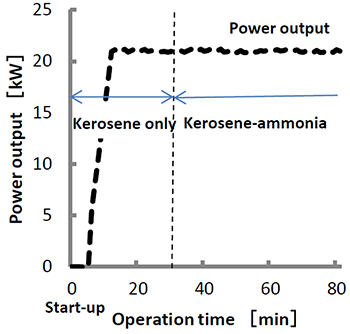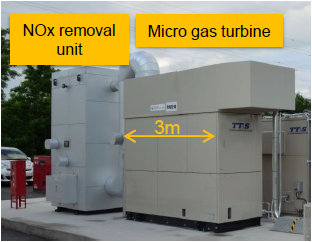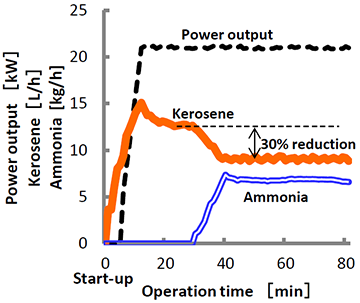Power generation technology for ammonia combustion in a gas turbine

Researchers have successfully generated 21 kW of power using a gas turbine driven by bifuel where kerosene equivalent to 30 % was replaced by ammonia in a commissioned research under the Energy Carrier project of the Cross-Ministerial Strategic Innovation Promotion Program of the Council for Science, Technology and Innovation.
Ammonia is anticipated to be a hydrogen carrier with high hydrogen content. In this research, a prototype combustion unit was built that enabled kerosene (liquid) and ammonia (gas) to be fed, and ammonia was combusted in a gas-turbine generator. This can be said to be a great step forward for ammonia in energy-use technology, and power generation using 100 % ammonia is anticipated.
In recent years, expectations are rising for hydrogen and hydrogen carriers as a medium for storage and transportation of energy in the mass introduction and use of renewable energy. Storage and transport of hydrogen is an important issue since hydrogen is a gas under normal temperature and pressure. Hydrogen carriers are mediums that convert hydrogen into chemical substances containing large amounts of hydrogen, to facilitate storage and transport. Hydrogen carriers include organic hydrides that are used by absorption and desorption of hydrogen to and from organic solvents (methylcyclohexane, etc.) and ammonia synthesized from nitrogen and hydrogen that is used by direct combustion. Ammonia is gaining particular attention as a hydrogen carrier that does not contain any carbon atoms and has a high hydrogen ratio. Expectations are on the rise for its use as a power-generating fuel. Since ammonia will generate mainly water and nitrogen on combustion, replacing a part of conventional fuel with ammonia will have a large effect in reducing carbon dioxide emissions.

AIST is promoting R&D of hydrogen carriers that support the mass introduction of renewable energy and is also involved in the development of technology to directly burn ammonia in a gas turbine for power generation in collaboration with Tohoku University. Ammonia has many issues, such as its difficulty to ignite compared with general fuels and its slow burning velocity, and gas-turbine power generation using ammonia as fuel had not been achieved. However, with increasing expectations for the use of ammonia as a hydrogen carrier, efforts were made to verify its potential as a power-generation fuel, using a gas turbine that is able to run on diverse fuels. The demonstration was conducted at the Fukushima Renewable Energy Institute (established by AIST in April, 2014 in Koriyama, Fukushima, Japan)
This R&D constitutes a part of the Energy Carrier project of the Cabinet Office SIP (Cross-Ministerial Strategic Innovation Promotion Program) started in fiscal year 2014.
Figure 1 shows the developed micro-gas-turbine generator. A combustor with a twin-fuel system to feed both liquid and gaseous fuel has been trial manufactured for stable bifuel combustion of kerosene and ammonia. Using a gas-turbine power generator with a rated output of 50 kW, ammonia equivalent to approximately 30 % was added to kerosene and bifuel combustion was conducted at approximately 40 % of the rated output, at 21kW, successfully generating almost the same output as mono-fuel combustion of kerosene alone. Nitrogen oxide (NOx) in the exhaust gas was suppressed to less than 10 ppm by feeding an adequate amount of ammonia gas to a normal NOx removal unit, fully meeting the environmental standards.

The gas turbine was started using only kerosene, and when stable power generation of 21 kW was achieved, nitrogen-ammonia mixed gas was fed into the gas feed line to start the combustion of ammonia. The ratio of ammonia was gradually increased and the nitrogen feed was cut in the end to realize kerosene-ammonia bifuel combustion. When power output was maintained at a certain level during operation, the feed of kerosene could be reduced by the heat of ammonia combustion. Stable power output was maintained at 21 kW under a condition where the feed of kerosene was reduced by 30 % (Fig. 2). This demonstration of gas-turbine power generation using ammonia as a fuel is the first of its kind in the world.
The researchers will continue with demonstration using kerosene-ammonia bifuel combustion with an increase in the ratio of ammonia, natural gas-ammonia bifuel combustion and ammonia mono-fuel combustion (CO2 free, soot free).
Provided by Advanced Industrial Science and Technology



















